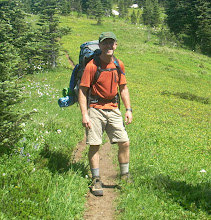 I rode my bike to the workshop at the Lincoln Center. There is no bike rack so I started to lock my bike to a column. I was politely asked to lock it up "on one of those wood pillars over there." (circled in yellow) The irony of this happening at a transportation visioning workshop was not lost on me.
I rode my bike to the workshop at the Lincoln Center. There is no bike rack so I started to lock my bike to a column. I was politely asked to lock it up "on one of those wood pillars over there." (circled in yellow) The irony of this happening at a transportation visioning workshop was not lost on me.Maps of Spokane County were on display in the back of the room showing land use (commercial, residential, etc.), road network, proposed bicycle network, proposed high performance transportation network (bus and rail), and freight network (roads and rail). About forty people were in attendance.
The workshop was conducted by MIG, a consulting firm working with the Spokane Regional Transportation Council. They presented a broad, high-level, yet fairly comprehensive review of land use, road networks, etc., that mirrored the information presented on the displayed maps. Lots of points were brought up by some in attendance about transportation access for seniors, creating livable communities, and emphasizing development that promoted and allowed walking to work, school, stores, etc.
We were asked what Spokane's strengths were and many were mentioned. A good education infrastructure, parks, the arts, historical preservation, variety and availability of sports and activities to mention a few.
After that we went through a vague questionnaire on community values and checked which ones we highly value, somewhat value, and don't value. Categories like Interregional Connectivity, Regional Perspective, and Self-Determination/Independence created questions and required clarification. The few in attendance chipped in with lots of good feedback, but since this was on such a high level I'm not sure how useful it would be to MIG without associated demographic information. Cyclists made up a larger proportion of the group than normal. I'd put the median age of everyone there at 45 years or higher. Maybe one person there was in the 20-30 year range.
One point brought up was that the price of gas, which always has an effect on transportation, had not been considered yet but would be in the future. The idea of $10 a gallon gas really increases the focus on local.
 Here is what the people attending listed as their most common mode of travel.
Here is what the people attending listed as their most common mode of travel. On this chart we noted what we'd like to change about our most common daily trips. Safety and proximity to other amenities were the top two.
On this chart we noted what we'd like to change about our most common daily trips. Safety and proximity to other amenities were the top two.Overall, the workshop was interesting and useful, but the point that there are also business and political forces to be reckoned with reminded everyone that an egalitarian transportation system is not something that's automatically going to happen.

No comments:
Post a Comment